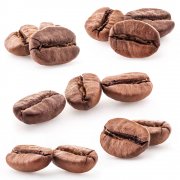The way of sieve grading is to grade according to the size of raw coffee beans. The raw bean passes through the iron with holes.
Classification according to screen
The way of sieve grading is to grade according to the size of raw coffee beans. Raw beans are graded by determining the size of the beans through a holed iron plate sieve. The size of the hole in the screen is 1x64 inches (less than 0.4mm), so the size of the screen indicates that there are several 1x64 inches. For example, the size of screen 17 is 17x64 inches, which is about 6.75mm, so the larger the number of the screen, the bigger the particles of raw coffee beans. The reason for this grading is that beans with large grains sell better and are more likely to produce rich and varied flavors than small ones. But this is not to say that beans with large grains are of better quality than beans with small grains. Ethiopian coffee beans are generally narrow and small, but their taste is the most unforgettable and favorite, including Yunnan's small seed coffee. it is also highly appraised by the international market. Kenya is one of the most representative countries rated by sieve, along with Tanzania and Colombia (some countries use more than one classification, and the examples given here are representative, mainly in this way). Kenya's most advanced AA++ requires sieves larger than 18, that is, beans larger than 7.15 mm. Kenya beans are graded carefully, including AA++,AA+,AA,AB and so on. Colombia's classification is simpler, divided into Supremo (selected) and Excelso (upper) according to bean size. 80% of the raw beans of the selected grade need to use a sieve of more than 17, and 80% of the raw beans of the upper grade need a sieve of 14 and more than 16, and a maximum of 11% of the beans with sieve 16 are allowed to be mixed with 14 sieve beans. The screen mentioned above is for flat beans, round beans (Pea Berry) has its own set of screen size standards. Generally use the screen of 8Murray No. 12 to grade the round beans.

Important Notice :
前街咖啡 FrontStreet Coffee has moved to new addredd:
FrontStreet Coffee Address: 315,Donghua East Road,GuangZhou
Tel:020 38364473
- Prev

General knowledge of Coffee Coffee grading system is summarized according to the altitude of coffee producing area.
The classification criteria such as the altitude classification of coffee producing areas are mainly because the quality of coffee produced at high altitude is generally higher than that at low altitude, because high altitude and low temperature, slow coffee production is conducive to the accumulation of good substances. And the raw beans with high maturity have good expansibility when baking, which is beneficial to baking, and the quality is more stable. Coffee production using this grading standard at present
- Next

Grading according to the proportion of sieve and defective beans
Grading defective beans according to the ratio of sieve and defective beans is an important factor in destroying the flavor of the final coffee. Therefore, defective beans should also be removed in the final step of green bean processing. Therefore, according to the proportion of defective beans, supplemented by screen size is also used as a classification method. Due to the rise of the fine coffee trend, coffee producing countries are paying more and more attention to the quality of coffee. Controlling defective beans is the most important way.
Related
- Beginners will see the "Coffee pull flower" guide!
- What is the difference between ice blog purified milk and ordinary milk coffee?
- Why is the Philippines the largest producer of crops in Liberia?
- For coffee extraction, should the fine powder be retained?
- How does extracted espresso fill pressed powder? How much strength does it take to press the powder?
- How to make jasmine cold extract coffee? Is the jasmine + latte good?
- Will this little toy really make the coffee taste better? How does Lily Drip affect coffee extraction?
- Will the action of slapping the filter cup also affect coffee extraction?
- What's the difference between powder-to-water ratio and powder-to-liquid ratio?
- What is the Ethiopian local species? What does it have to do with Heirloom native species?

